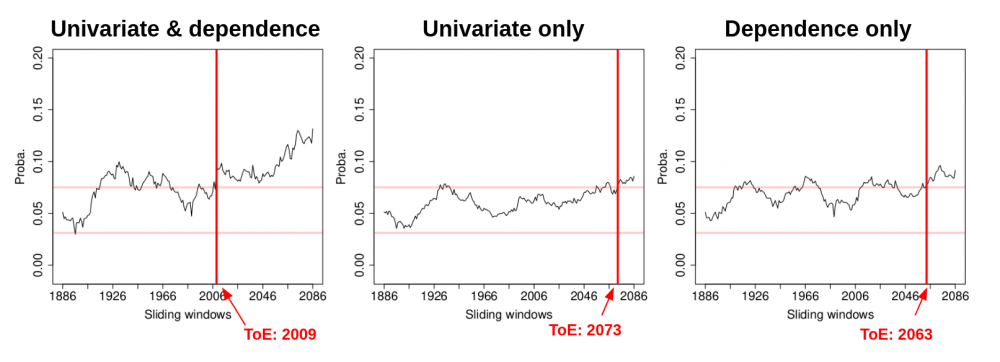
Probability changes of compound wind and precipitation extremes based on CNRM-CM6 simulations due to changes of (a) both univariate and dependence properties, (b) univariate properties only, and (c) dependence properties only. Times of Emergence of compound events probabilities with respect to the reference period (1871-1900) are displayed with vertical red lines. When considering univariate properties only (b), and dependence properties only (c), probability time series emerge in 2073 and 2063, respectively. However, when considering both univariate and dependence changes together (a), a sooner Time of Emergence is obtained, suggesting that changing statistical properties combine to get an earlier emergence of compound event probabilities. See [4] for more details and results.
When could compound events emerge in the future? Separating changes in univariate and dependence properties
High-impact climate events such as floods or wildfires often result from interactions between several climate phenomena, also referred to as “compound events” [1]. Evaluating the probability of compound events and their emergence from natural variability is crucial, e.g., for adaptation and mitigation strategies [2, 3]. Univariate and multivariate properties of climate variables forming compound events are key statistical properties characterizing their probabilities of occurrence. Using copula theory, we proposed a new methodology to assess the Time of Emergence of compound events probabilities and to quantify the contribution of univariate and dependence properties to the overall probability changes [4]. We applied our methodology to a 13-member multi-model ensemble (CMIP6) to analyze two compound events with potential high-impacts:
-
Compound wind and precipitation extremes over the coastal region of Brittany (France)
-
False springs, i.e., frost events occurring during the growing season preconditioned by warm temperatures over Central France.
For compound wind and precipitation extremes, results show that probabilities emerge before the end of the 21st century for 6 models in the ensemble. For false spring events, significant changes in probability are detected for 11 models. However, the reason for these changes of probabilities can be very different: while, for some models, probability changes are mainly driven by univariate changes only, other models give a strong importance to both univariate and dependence properties.
The results highlight the importance of considering both univariate and dependence properties changes, as well as their inter-model variability, for future risk assessments due to compound events. Of course, further research is needed, such as investigating if climate models are able to realistically simulate compound events probabilities and their evolutions compared to observations.
[1] Zscheischler, J. et al., Future climate risk from compound events, Nat. Clim. Chang., 2018.
[2] Lobell, D. B. and Burke, M. B., Why are agricultural impacts of climate change so uncertain? The importance of temperature relative to precipitation, Environ. Res. Lett., 2008.
[3] Hawkins, E. and Sutton, R.: Time of emergence of climate signals, Geophys. Res. Lett., 2012.






